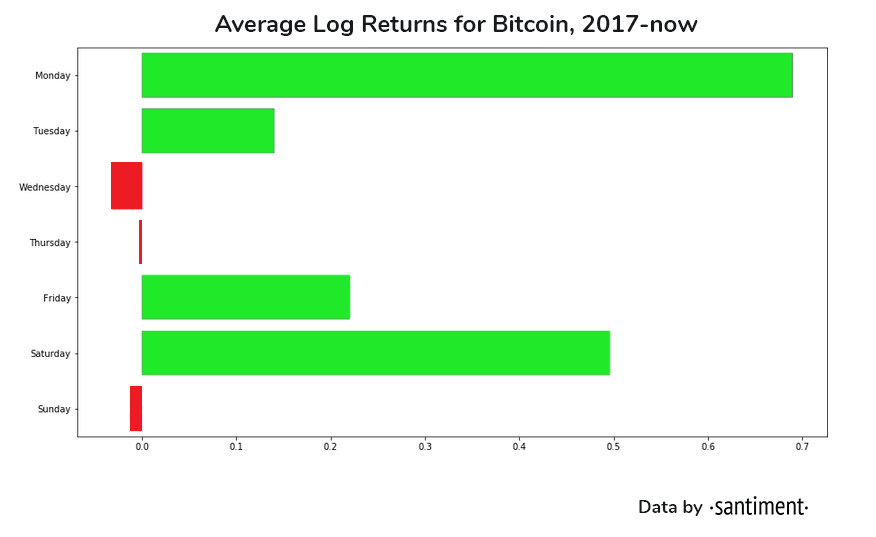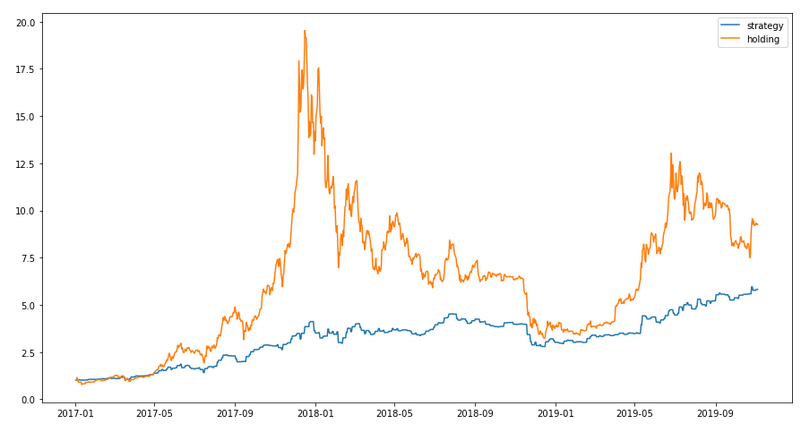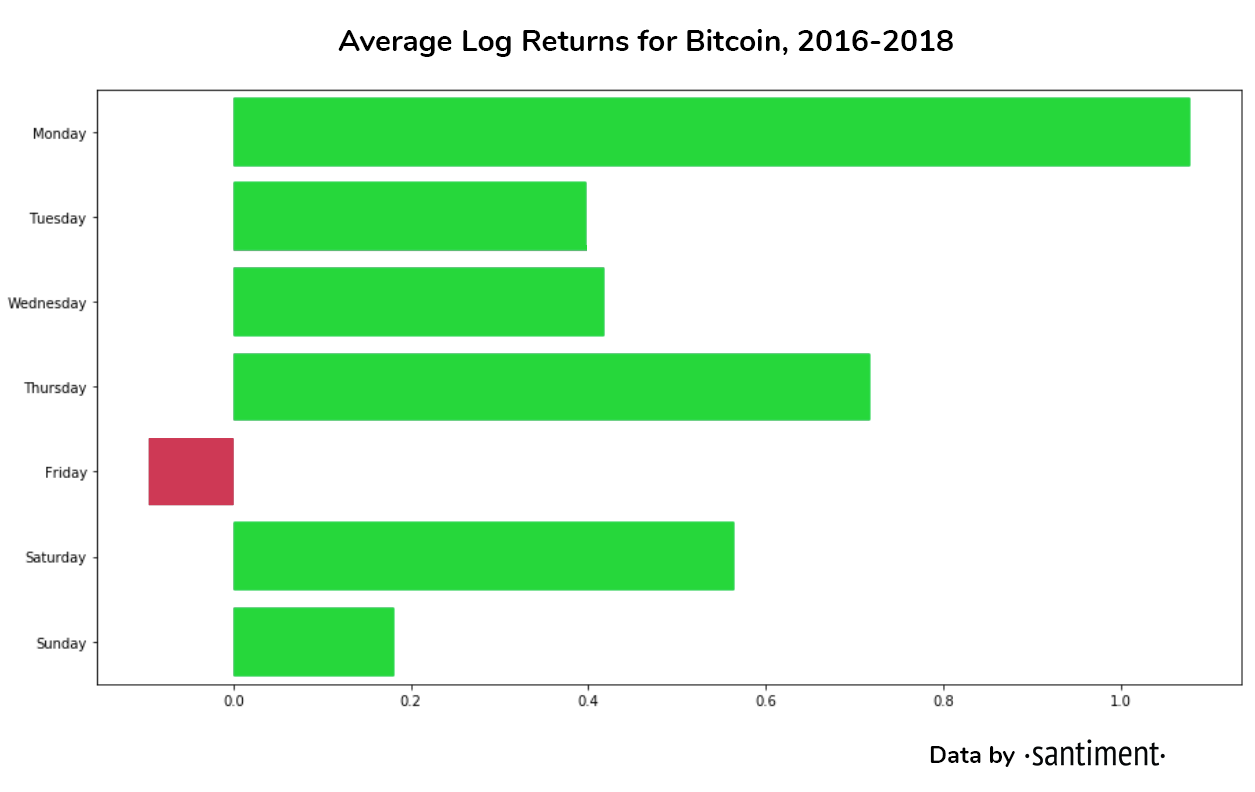Data to | Within a week, the day of trading BTC will not be lost?

Strength is not enough, strategy to make up.
I believe that many currency friends who have invested in stocks should know a more interesting phenomenon: in a week, there are always days that are more likely to make profits or losses than other days.
For example, when French found on the New York Stock Exchange that the stock's return on Monday was usually lower than the previous Friday, the phenomenon had a term called “weekend effect”. The scholars concluded that listed companies usually publish bad news after the stock market is suspended on Friday (this move is now also learned by A shares).
- Nintendo, Atari, Sony, the former king battle, how to influence blockchain games?
- Alipay and WeChat payment have been very convenient and practical. Why does the central bank still launch DCEP?
- DeFi: Ether Exodus?
On the other hand, the currency circle has always been 7*24 hours, but today's “day market” has quietly entered the encryption market for some time. The currency believes that this is because many large households are equipped with professional trading teams and institutions, so working hours in Europe, America and Asia are the easiest time to change. For example, 7-9, 3:5.
However, so far, there has not been much research on the "day of the week" effect of the encryption market.
- Is the same rule applicable to the currency circle?
- Buying coins on Monday + selling coins before the weekend = tender villa?
- What is the "best trading day of the week" in the encryption market?
Let us speculate one by one.
Test the strategy of " Best Deal Date of the Week " :
To find out, let's take a closer look at the " BTC Average Price Return " for each day, including weekends. As the major analysts often do, we use BTC as a barometer for the entire encryption market, because many altcoins (altitude coins) are linked with BTC, and the independent market is a minority.
First, let's look at the average daily rate of return for the week from 2017 to now (different dates per week):

(2017.1.1 – to date, the average rate of return of Bitcoin at different times of the week)
Here we need to emphasize: we are here the gold standard. When calculating the average rate of return, you will encounter the problem of adding positive and negative returns. Imagine that Bitcoin fell 50% and rose 50% the next day. At this time, the average return rate of fools is 0%, but the actual rate of return is -25%. Because you lost half of the money first, then the remaining half of the money rose by 50%. That is to say, one coin fell 50% on the day, and the second needs to double to return.
As shown in the above figure, there are some big differences in the return rate of BTC in different working days:
The most significant gains were on Monday and Saturday , with average returns of +0.69% and +0.5%, respectively.
For example, if the currency is bought from Bitcoin every Saturday from the beginning of 2017 to today, and then sold before the end of the day, then the current bitcoin return on investment will be positive (green).
The data for Wednesday, Thursday and Sunday are negative. So far, Wednesday is the worst day of performance.
Of course, relying solely on the above strategies to formulate investment plans is too arbitrary and requires further argumentation.
With this information, we continue to test the “BTC Weekly Investment Strategy”.
Starting in 2018, we only buy Bitcoin on Mondays and Saturdays and sell them at the end of the day. So what is our return on investment?

(The y-axis represents a multiple, and 1 represents a flat, such as 1.2 for 20%, and 0.6 for loss -40%)
The blue line indicates our intraday investment strategy for the week, the orange line, which we use as a benchmark to show the calculation of the long-term BTC income from the same time (hereinafter referred to as the benchmark return, which is positively related to the currency price trend).
Within the observed time frame, our intra-week strategy resulted in a 68% profit, while those who held the bitcoin would suffer a 38% loss.
From the model point of view, the worst case is that the plunge at the end of 2018 (caused by the BCH community split) also occurred on Monday, which made our strategy a major mistake, and rarely close to the benchmark earnings. But despite this, our daily strategy achieved relatively steady growth for most of the bear market in 2018, and exceeded the benchmark yield without any pressure.
But further research in the past will also have interesting results. From 2017 to today, we will backtest the strategy of the day and we can get the following results:

(From 2017 to today, only on Monday and Saturday.)
This time, our strategy does not actually exceed hoding (BTC long-term holder), considering that 2017 is a bitcoin bull market, in this extended time test framework, our daily strategy has only a profit return of 469% – It is about 71% of the benchmark return.
Although it seems that we have made a very stupid X investment strategy, it should be noted that we only traded for two days in a week and got a benchmark return of 71%. In addition, the volatility exhibited by these two strategies is also vastly different.
Most importantly, the long- term process of letting investors invest is like riding a roller coaster , and they are also at greater risk . Although those who invested in the encryption market in 2012 and sold coins, they may now have wealth free.
But the currency is skeptical that that era may have completely passed.
Our daily strategy will weaken most of the BTC's risk of volatility. During the time frame tested, we can see that the method is a slow but stable, and almost continuously rising investment strategy.
From the numerical point of view, the annual standard deviation of our daily strategy during the observation period is 0.43, and the annual standard deviation of holding is 0.84. Our strategy has an annualized Sharpe ratio of 1.65 and a long-term holding of 1.35.
*(This is explained by the currency friends who do not understand financial terms. Standard deviation is a common standard for measuring risk. Generally, it is divided into daily, weekly, monthly and annual (standardization difference). The higher the standard deviation is, the higher the risk is; The annualized Sharp ratio originally refers to the standardization index of fund investment performance evaluation, which is one of the classic indicators. The Sharpe ratio can comprehensively consider the benefits and risks at the same time. The larger, the higher the risk return obtained by the unit unit risk.)
It can be seen that our intraday investment strategy significantly reduces volatility, improves risk-adjusted returns, and provides investors with a better risk-benefit balance.
The bitcoin-led encryption market is so volatile that it has been the reason for many newcomers and traditional financial institutions to wait and see. Especially in the early days of the currency circle, it was the money that was poor in information and capital strength, and the latter relied on cognition and understanding. For our small retail investors, the investment strategy will definitely be more important than the K-line technical indicators.
Even on the face of the disk, our return on investment is not as good as the long-term benchmark return, but on the other hand, our strategy is to sacrifice some revenue but significantly reduce the risk of uncertainty. After all, no one can determine the future trend. Otherwise, you should buy Bitcoin in 2010.
However, some people may also question: Is this strategy not a post-mortem?
Indeed, we are speculating from historical data. In fact, many people who make models know from the beginning what data at any point in time can be argued in the same framework. Pre-entry is really not bad or stupid , especially in 2020 , and the model is still effective in the face of fluctuations caused by such historic events.
So let's test again from 2016, when the market sentiment was similar.
* (The newcomers are also taken care of here, July 10, 2016 is the third halving of Bitcoin history, which is the last halving.)
The following is the weekly return on the week of 2016-2017:

(BTC average daily income during the period from January 1, 2016 to December 31, 2017)
Considering the bullish trend of Bitcoin in 2016, the results we get are actually very similar to the calculation of the daily return in the week of 2017-2019.
In the bull market, the best performance is still on Monday, plus a new second place on Thursday , Saturday is also good, and the previous model 0.5 is not much different. Although Wednesday and Sunday (the worst day before) return positive. Don't be surprised, because this is a bull market.
With these results (we chose the big bear market after halving in 2018), we decided to trade Bitcoin on Monday, Thursday and Saturday and sell it at the end of each trading day.
The following are the results of our investment strategy since January 2018:

(Starting from 2018, trading only on Monday, Thursday and Saturday)
Since only the past data is available, we have once again outperformed the long-term benchmark return, compared to their -38%, we only lost 4%. The currency feels good, and the original investment is a game. Winning most people will eventually make money.
Therefore, our model has also proved that for the BTC traders in the currency circle: the bull market is more likely to make a profit in Monday, Thursday and Saturday, and the bear market is less likely to lose at least.
However, there is one point to note. Although most of the mainstream currencies in the broader market are linked to Bitcoin, the trend of individual CX and altcoin is estimated to be known only to the dealer. Investors who use this strategy also need to have some basic financial investment experience.
References in this article: "Backtesting the week: Which days are best for trading crypto?"; The author: Jan.S;
We will continue to update Blocking; if you have any questions or suggestions, please contact us!
Was this article helpful?
93 out of 132 found this helpful
Related articles
- Viewpoint | Data visualization of stable currency DAI
- Mosaic/Coinbase Joint Report: Development Status of Anonymous Coins
- Jianan listed plans to raise 100 million US dollars, the source: or due to the poor performance of the road show, the amount of funds raised
- The hacker group Anonymous announced the establishment of a $75 million Bitcoin fund to boost privacy technology and cryptocurrency development
- Viewing the Governance and Game Theory under the Chain from the Merchant Law in the Middle Ages
- The Swiss Stock Exchange is based on the XTZ-based ETP, and investors can get XTZ staking income.
- Morgan Creek CEO: Every asset in the world will be tokenized, selling Amazon stock to buy bitcoin






